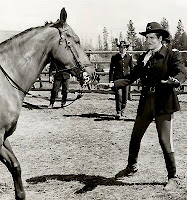This next Disney live-action film in the line up I had no clue existed. Looking at the movie poster for Tonka, my guess was the Native American standing in the foreground was Tonka, but it is the brown chestnut horse in the background that bares the title role. Once I learned it was about the horse, I assumed it's another Black Beauty mixed with all the other horse movies like Spirit, The Littlest Outlaw, and even War Horse ( and yes I know some of those films came out way after this film was made). These films are all pretty much the same: the obsession between a horse and its "owner". In this film there is even the sad/angry goodbye scene that a lot of other animal films like Old Yeller or even the classic Harry and the Hendersons. You know, where the owner sets their animal friend free in order to protect them. They first start off with the heartfelt watery-eyed goodbye and it turns into the " Go get out of here, don't you understand?" yelling. I'm sorry reader, I find these scenes don't have the same effect on me as a true animal lover. I just find these scenes to be too overdramatic. Anyway, the film is about a boy and his dedication to a horse. Of course there is much more to it. The press book for the film stated that Tonka was " the first full-scale movie attempt to tell the battle story of Custer's Last Stand from the Indian view point." Typically, in any western film Native Americans are portrayed as savage and white settlers/ military as civil. This time General Custer is painted as the savage villain.
Ok, let's back track a little so you know what the heck I'm talking about and the history of Tonka. The story idea for Tonka came from the book, Comanche: Story of America's Most Heroic Horse by David Appel. It is a fictional story told from the horse point of view of the true events of the only survivor of the Battle of Little Big Horn. No Custer soldier survived, but a lone horse named Comanche owned by Captain Myles Keogh of the 7th Cavalry did. Comanche was badly injured in battle but recovered and went into retirement until its death twelve years later. He received a military funeral with full honors. Comanche was then stuffed and in 1893 was on display at the Exposition in Chicago and then found a permanent home at Kansas University Natural History Museum.
Disney bought the rights to the story Oct 1956 and started production two years later in April of 1958.
Originally like most of his other full length features he had only planned it to be a TV two-part series but changed his mind. He hired Lewis R. Foster as director, who was probably best known for his writing of the award winning film Mr. Smith Goes to Washington starring Jimmy Stewart. So where does the name Tonka come from? Well in Disney's adaptation Tonka Wakan ( The Great One) gained his name from White Bull the Indian brave who found him and trained him. Later in the film Tonka is named Comanche as he was by the real Captain Keogh. The 1870's Dakota Territory was filmed in Bend, Oregon at Warm Springs Indian Reservation. Supposedly, more than 500 Indians were used as warriors of Sitting Bulls army and 25 residents of Bend and Mandras were used as Calvary soldiers. If you are looking for a politically correct film, this is not it. Like most films of it's day a white person was made up to look like an Indian. This was true for most of the main Native American characters in the film. Casting the film, Disney wanted to stick with someone audiences were familiar with and liked, so he turned to Fess Parker. He was scheduled for the role of Captain Myles Keogh and tested for the part on May 27,1958. Though as soon as Parker found out that once again he was going to play second fiddle to another teenaged boy like he did for Old Yeller, he was not happy and refused to play the role. He was also unhappy with Disney for refusing to lend him out to other studios, missing out on the chance to be in John Ford's The Searchers. So Parker was put on suspension and left Disney studios for good. He only would return later in his life to appear in special features related to films like Davy Crockett and Old Yeller. Taking on the role of Captain Keogh then became the job of Philip Carey. He, along with many in the cast, had a lot of experience with Westerns.From a biography about Sal Mineo written by Michael Gregg Michaud it reveals that Sal did not care for the film at all. He found the film beneath him and probably holds a grudge even more for it because of the injuries he received while filming. He fractured his left knee cap when he fell from his horse during filming of the battle scene. He was expected to be on crutches for 3 weeks and wear a plaster splint for 6 weeks and only taking part in some action scenes that did not call for riding, running or heavy activity. He wasn't the only actor that had been injured. Cuts, fractured ribs and hoof marks were left on an extra's body along with another one suffering from a fractured wrist and a strained ankle.
The horses weren't so lucky, either. Horses slipped on rocks and collided with each other during the battle scene, so it definitely made the battle seem more real.





No comments:
Post a Comment
Note: Only a member of this blog may post a comment.